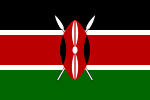Sabaot people
This article needs additional citations for verification. (March 2018) |
| Regions with significant populations | |
|---|---|
| Languages | |
| Sabaot language | |
| Religion | |
| Christianity, Traditional African religions | |
| Related ethnic groups | |
| Kalenjin people |
| Part of a series on the |
| Culture of Kenya |
|---|
 |
| Cuisine |
The Sabaot are one of the nine sub-tribes of the Kalenjin of Kenya and Uganda. The Sabaot in turn are divided into six sub-tribes largely identified by their dialects. These dialects of the Sabaot language are the Pok, Somek, Mosop, Koony, Bong'omek and Sabiny (Sebei Uganda). Being resident around Mount Elgon, the original homeland of most Kalenjin, the Sabaot are seen as the keepers of the authentic Kalenjin tradition. They and the area they inhabit are often referred to as Kapkugo (meaning grandparents/ancestors place) by other Kalenjin.
Origins
[edit]The Sabaot were among the Southern Nilotic-speaking communities, i.e. proto-Kalenjin, who moved into the western highlands and Rift Valley region of Kenya around 700 BC. Their homelands lay somewhere near the common border between Sudan, Uganda, Kenya and Ethiopia. Their arrival in Kenya occurred shortly before the introduction of iron to East Africa.[1] Contemporary studies, supported by a number of historical narratives from the various Kalenjin sub-tribes point to Tulwetab/Tuluop Kony (Mount Elgon) as their original point of settlement in Kenya.
Settlement
[edit]Oral tradition
[edit]The traditional account states that most Sabaot once lived at a place called Sengwer which is near the Cherangani Hills. The patriarch of the Sabaot community is said to have been a man called Kingo who moved to Kony from Sengwer. It is said that Kingo had four sons; Chebok, Chepkony, Chesabiny and Chebong’Om. These sons or one of them at least once broke a gourd belonging to their father and Kingo being very mad banished them from their home. The four sons dispersed, some to Bungoma and others to areas further south and west. Wherever each of these sons went, they established a clan and at a later date these clans returned becoming the main clans of the Sabaot community.[2]
Traditional life
[edit]Initiation
[edit]Like other Kalenjin and a number of East African societies, the Sabaot traditionally practiced male and female circumcision. Male circumcision was meant to enhance cleanliness and bravery while female circumcision was practiced to reduce promiscuity.
Economic activities
[edit]In previous times, the Sabaot had vast lands which allowed for a pastoral lifestyle. With decreasing land size, the Sabaot have been forced to drastically change their lifestyle from cattle herding to planting maize (corn) and vegetables.[3]
Culture
[edit]The principal reference points in the Sabaot identity have been land and cattle both of which are coming under increasing threat, from growing land shortages and decreasing pastoralism respectively, which along with a decline in the practice of certain traditional customs such as initiation and polygamy have led to a sense among the Sabaot that their identity is under threat.[4]
Notable people
[edit]- Hon.Jonson Authur Sakaja, Politician,Governor Nairobi county
- Hon.Fred Kapondi, politician and a member of parliament, Mt. Elgon Constituency.
- Caxton Masudi Ngeywo former Deputy commissioner Kenya Revenue Authority (KRA),cosultant world bank based in
Dubai,UAE
- [Mr.Chamngei Cheworei Kiboi-Pioneer Educationist and teacher in Mt. Elgon
- Hon Lawrence cheshari Mokosu former MCA kinyoro ward
- Wilson chemasuet Kenya Civil aviation Authority (KCCA)
- Dr. Robert Pukose, Medical Doctor & politician, a member of parliament, Endebess Constituency[5]
- JOHN BOMET SERUT, late member of parliament mt elgon kenya
- Maruga mca chesikaki ward cheptais district.
- Joshua Aramis upcoming politician and influencer student leader kenyan kalenjin communities
- Moss Ndiema, Politician, Secretary General, Kenya Aviation Workers Union (KAWU), Kenya
- William Chemonges, Politician,MP. Kween, Uganda
- Hon.Rose Emma Cherukut, Politician,Woman MP. Kween District, Uganda
- Hon.Abdi Fadhil Kisos Chemaswet, Politician, MP. Soi County, Uganda
- Reuben Paul Chelimo, Politician, MP. Kongasis, Uganda
- Hon.Solomon Malinga Chelangat, Politician, MP. Too, Uganda
- Hon.Everlyn Chemutai, Politician,Woman MP. Bukwo District, Uganda
- Twalla Fadhil, Politician, MP. Tingey, Uganda
- Hon.Sam Cheptoris Mangusho, Politician, MP. Kapchorwa Municipality, Uganda
- Hon.Phyllis Chemutai, Politician,Woman MP. Kapchorwa District, Uganda
- Moses Masai, Olympian, 10000m bronze medallist
- Linet Masai, Olympian, 2009 World 10000m champion
- Milcah Chemos Cheywa, World Champion 3000m Steeplechase[6]
- Joshua Cheptegei 5000m Olympic champion, 10000m World champion. Kapchorwa District, Uganda
- Cellphine Chesipol, athlete
- Mercy Moim, Volleyball Captain,Kenya National Team
- Hon.Allan Chesang, Senator, Tranzoia County
- Hon.Lilian Siyoi, Woman Representative, Tranzoia County
- Hon.Philomena Kapkory, Deputy Governor, Tranzoia County
- Hon.Janepher Mbatiany, Deputy Governor, Bungoma County
- Paul Kiptoo Masaba, Bishop, Sebei Diocese, Church of Uganda
- Bishop.Emmanuel Chemengich, ACK, Bishop Diocese of Kitale
- Ben Jipcho, an Olympian
- Peter Kemei, Gender Equality Advocate, Top 60 @60, Kenya[7]
- Rev. Dr. Ptallah Butaki, Founder and Executive Director Imani Radio & Tv, Kenya and Uganda
- Davis Kipkania Kiboi, Engineer and Academician from Chepkube, Mt. Elgon
- Prof. George Chemining'wa, Principal, Turkana University College
References
[edit]- ^ Clark, J., & Brandt, St, From Hunters to Farmers: The Causes and Consequences of Food Production in Africa. University of California Press, 1984, p.234
- ^ Mountain Voices, Hezron, Kenya 14
- ^ Historical and Current Facts about The Sabaots, sabaot.com/history
- ^ Mountain Voices, Sabaot - Identity
- ^ Sabaots not marginalised by government – Kapondi, Kass Weekly
- ^ Moses out to deliver ‘Caanan’ in London, Citizen
- ^ "Kenya@60: The men who proudly stood up for gender equality". 9 June 2023.
